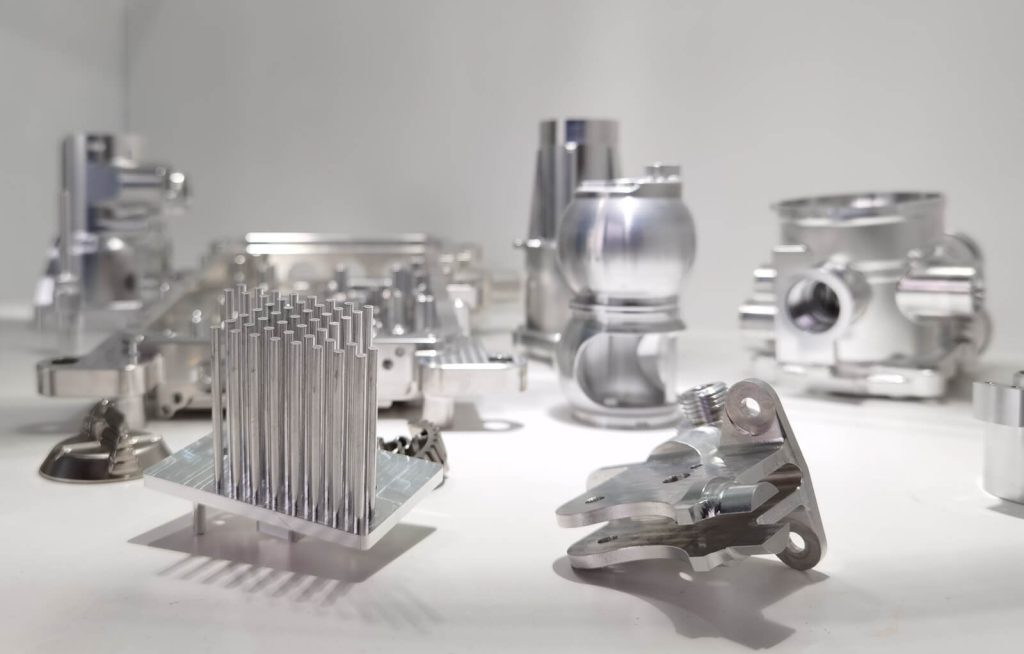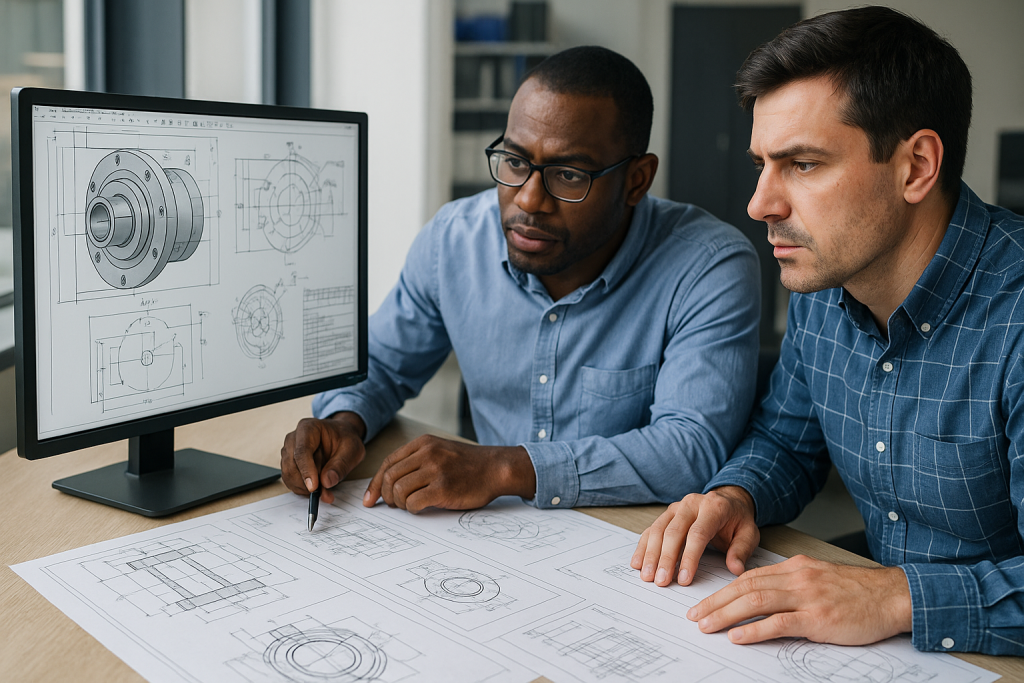When creating metal prototypes, functionality isn’t the only concern—appearance, durability, and performance are also crucial. Surface finishing plays a key role in ensuring that your prototype looks good, performs well, and withstands environmental or mechanical stress. In this guide, we’ll explore seven common types of surface finishing used in metal prototyping, along with a comparison table to help you choose the best option.
If you’re looking for professional prototyping and finishing services, visit Boona Prototypes for full solutions including CNC machining and surface treatment.

I. As-Machined Finish
Overview: The default finish for CNC parts. No additional surface treatment is applied.
-
Appearance: Slight tool marks visible
-
Roughness (Ra): ~3.2 μm
-
Best for: Functional prototypes where aesthetics are not critical
Benefits:
-
Fast and cost-effective
-
Preserves dimensional accuracy
-
Ideal for engineering validation
II. Bead Blasting
Overview: A stream of tiny glass beads is sprayed under pressure to create a smooth, matte surface.
-
Appearance: Uniform satin or matte
-
Roughness (Ra): ~1.6–3.2 μm
-
Best for: Aesthetic prototypes and pre-coating preparation
Benefits:
-
Removes tool marks and minor surface defects
-
Enhances surface texture and grip
-
Common prep for anodizing or painting
III. Brushed Finish
Overview: An abrasive belt or pad creates a directional, linear grain on the surface.
-
Appearance: Satin with visible brush lines
-
Roughness (Ra): ~0.8–1.6 μm
-
Best for: Visible consumer electronics, home appliances
Benefits:
-
Attractive professional look
-
Consistent grain structure
-
Helps mask small imperfections
IV. Polishing
Overview: Mechanical or chemical process to produce a highly reflective, glossy surface.
-
Appearance: Mirror-like gloss
-
Roughness (Ra): ~0.2–0.8 μm
-
Best for: Cosmetic parts, luxury components
Benefits:
-
Improves visual appeal
-
Reduces friction
-
Ideal for stainless steel or aluminum alloys
V. Anodizing
Overview: Electrochemical process that forms a protective oxide layer on aluminum.
-
Appearance: Can be clear or colored (black, red, blue, etc.)
-
Layer Thickness: 10–25 μm (Type II), up to 50 μm (Type III)
-
Best for: Aluminum parts needing corrosion resistance and color
Benefits:
-
Increases wear and corrosion resistance
-
Offers decorative color options
-
Environmentally friendly and durable
For complete anodizing capabilities, Boona provides full details on their surface finishing options page.
VI. Powder Coating
Overview: Powder is electrostatically applied and cured to form a strong, colorful finish.
-
Appearance: Glossy or matte; available in many colors
-
Thickness: 60–120 μm
-
Best for: Consumer goods, metal enclosures, hardware
Benefits:
-
Resistant to scratches, chemicals, and UV
-
Uniform coating, even on complex shapes
-
No solvents or VOC emissions
VII. Electroless Nickel Plating
Overview: A chemical process that deposits a uniform nickel-phosphorus layer without electric current.
-
Appearance: Silvery, semi-gloss
-
Hardness: Up to 1000 HV after heat treatment
-
Best for: Complex parts needing wear and corrosion resistance
Benefits:
-
Even coating over internal surfaces
-
Excellent for high-precision parts
-
Compatible with most metals
VIII. Surface Finishing Comparison Table
| Finish Type | Appearance | Roughness (Ra) | Protective Strength | Color Options | Cost | Best For |
|---|---|---|---|---|---|---|
| As-Machined | Raw, tool marks | ~3.2 μm | ✖ Low | ✖ | $ | Functional testing |
| Bead Blasting | Matte | ~1.6–3.2 μm | ✔ Medium | ✖ | $$ | Aesthetic prototypes |
| Brushed | Satin | ~0.8–1.6 μm | ✔ Medium | ✖ | $$ | Consumer-facing parts |
| Polished | Mirror gloss | ~0.2–0.8 μm | ✖ Low | ✖ | $$$ | High-end aesthetic applications |
| Anodized (Type II/III) | Colored/Glossy | ~1–2 μm | ✔✔ High | ✔ Yes | $$–$$$ | Durable, corrosion-resistant parts |
| Powder Coated | Matte/Glossy | — | ✔✔ High | ✔ Yes | $$–$$$ | Outdoor & consumer product parts |
| Electroless Nickel Plated | Metallic silver | ~0.2–0.5 μm | ✔✔ High | ✖ | $$$ | Precision mechanical components |
IX. Choosing the Right Surface Finish
Choosing the right surface finish depends on the functional requirements and visual expectations for your metal prototype:
-
For corrosion resistance → Anodizing, Nickel Plating, Powder Coating
-
For aesthetics → Brushed, Polished, Bead Blasted
-
For cost-effectiveness → As-Machined or Bead Blasted
-
For precision → Electroless Nickel Plating
For a customized surface finishing recommendation, Boona offers one-stop prototyping services including consultation, CNC, and finishing in-house.
Final Thoughts
Each finishing method brings a unique combination of appearance, durability, and cost. Whether you need a fast prototype or a presentation-ready part, matching your finishing technique to the project’s goal is crucial.
Explore your options with a reliable partner like Boona Prototypes, who specialize in precision CNC machining and expert-level surface treatments tailored to various industries.
FAQs
1. Why is surface finishing important for metal prototypes?
Surface finishing improves not only the appearance but also the functionality of metal prototypes. It can enhance corrosion resistance, reduce surface roughness, improve wear performance, and make parts suitable for presentation, testing, or end use.
2. What is the most cost-effective surface finish?
The most cost-effective option is typically the as-machined finish, as it requires no additional processing. Bead blasting is also relatively affordable and offers a clean, matte appearance.
3. Which surface finish is best for corrosion resistance?
Anodizing (for aluminum), powder coating, and electroless nickel plating are all excellent for corrosion resistance. Among them, Type III anodizing and nickel plating provide the most robust protection.
4. Can multiple surface finishes be applied to a single part?
Yes. For example, a part may be bead blasted first to create a uniform texture, and then anodized or powder coated to add color and protection. Combining finishes can optimize both function and aesthetics.
5. How do I choose the right surface finish for my prototype?
Consider the following factors:
-
End-use environment (indoor/outdoor, exposure to chemicals or water)
-
Aesthetic requirements (matte, glossy, colored, mirror finish)
-
Material compatibility (e.g., anodizing works best on aluminum)
-
Budget and timeline
You can also consult experts at Boona Prototypes for tailored recommendations.
6. Does surface finishing affect the part’s dimensions or tolerances?
Yes, some processes like anodizing, nickel plating, or powder coating add a thin layer to the surface, which may affect tight tolerances. Always discuss your critical dimensions with the manufacturer to allow for appropriate adjustments.
7. What is the difference between anodizing and powder coating?
-
Anodizing is an electrochemical process that builds an oxide layer on aluminum, improving corrosion resistance and allowing colorization.
-
Powder coating is a paint-like finish applied as a dry powder and heat-cured, offering excellent durability and vibrant colors.
8. Is polishing suitable for all metals?
Most metals—including aluminum, stainless steel, brass, and copper—can be polished. However, polishing softer metals requires care to avoid over-removal of material or distortion.
9. How long does surface finishing usually take?
Typical finishing lead times:
-
As-machined: No extra time
-
Bead blasting or brushing: 1–2 days
-
Anodizing or powder coating: 2–4 days
-
Electroless nickel plating: 3–5 days
These may vary based on part quantity, complexity, and vendor capacity.
10. Do Boona Prototypes offer all these surface finishing options?
Yes. Boona Prototypes offers a wide range of finishing services including anodizing, powder coating, bead blasting, polishing, brushing, and nickel plating—all performed with high precision and quality control.



